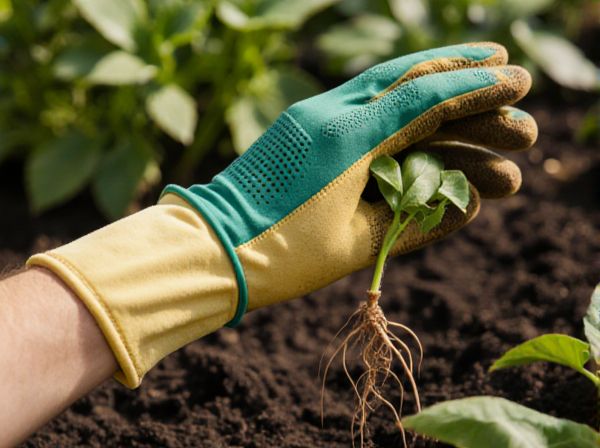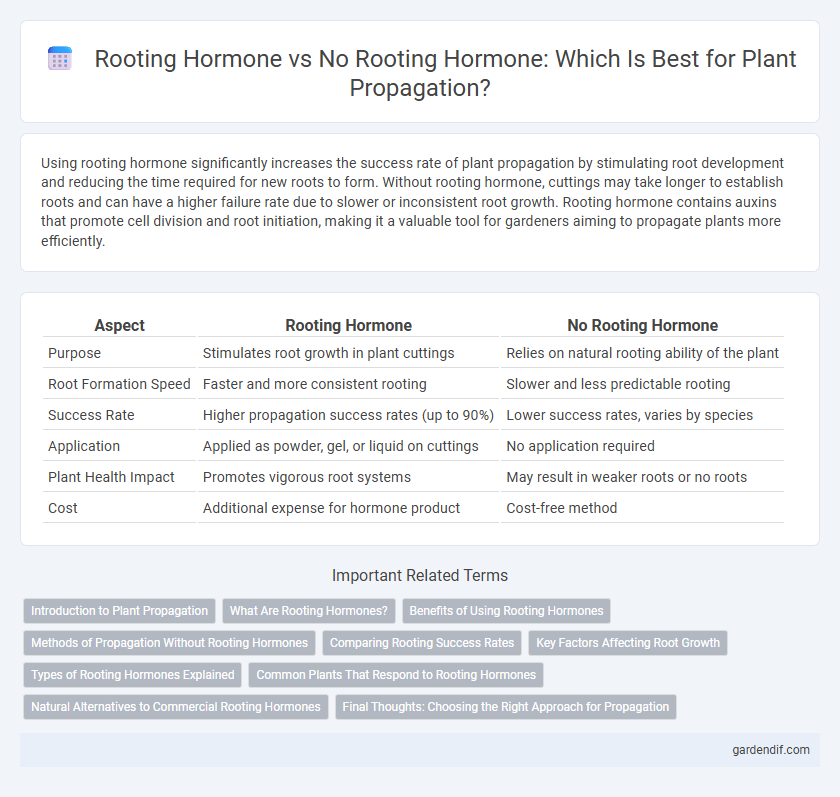
Rooting hormone vs No rooting hormone Illustration
Using rooting hormone significantly increases the success rate of plant propagation by stimulating root development and reducing the time required for new roots to form. Without rooting hormone, cuttings may take longer to establish roots and can have a higher failure rate due to slower or inconsistent root growth. Rooting hormone contains auxins that promote cell division and root initiation, making it a valuable tool for gardeners aiming to propagate plants more efficiently.
Table of Comparison
| Aspect | Rooting Hormone | No Rooting Hormone |
|---|---|---|
| Purpose | Stimulates root growth in plant cuttings | Relies on natural rooting ability of the plant |
| Root Formation Speed | Faster and more consistent rooting | Slower and less predictable rooting |
| Success Rate | Higher propagation success rates (up to 90%) | Lower success rates, varies by species |
| Application | Applied as powder, gel, or liquid on cuttings | No application required |
| Plant Health Impact | Promotes vigorous root systems | May result in weaker roots or no roots |
| Cost | Additional expense for hormone product | Cost-free method |
Introduction to Plant Propagation
Rooting hormone significantly enhances plant propagation by stimulating root development and increasing success rates compared to no rooting hormone. Without rooting hormone, cuttings may take longer to root and have a lower chance of survival, especially in species that are difficult to propagate. Using auxins like indole-3-butyric acid (IBA) in rooting hormone promotes faster and more robust root growth, crucial for effective plant propagation.
What Are Rooting Hormones?
Rooting hormones are substances that stimulate root development in plant cuttings by promoting cell division and growth at the cutting site. These hormones typically contain auxins, such as indole-3-butyric acid (IBA) or naphthaleneacetic acid (NAA), which enhance the formation of new roots and increase the success rate of propagation. Using rooting hormones can significantly accelerate rooting time and improve the survival chances of cuttings compared to propagation without any hormonal treatment.
Benefits of Using Rooting Hormones
Using rooting hormones significantly accelerates root development and increases the success rate of plant cuttings by stimulating cell division at the cutting site. These hormones promote uniform and robust root systems, reducing transplant shock and enhancing nutrient uptake efficiency. Compared to no rooting hormone, treated cuttings exhibit faster establishment, better growth, and higher survival rates in propagation efforts.
Methods of Propagation Without Rooting Hormones
Propagation methods without rooting hormones include techniques such as stem cuttings placed in water or moist soil, layering, and division. These natural approaches rely on the plant's inherent ability to develop roots, often requiring optimal environmental conditions like consistent humidity and temperature. Success rates may vary depending on species, but careful attention to moisture and light can enhance root formation without synthetic hormones.
Comparing Rooting Success Rates
Rooting hormone significantly increases the success rates of plant cuttings by stimulating root development and accelerating the rooting process compared to cuttings without any hormone treatment. Studies show that cuttings treated with rooting hormone can achieve rooting success rates of 80-95%, whereas untreated cuttings often root at rates below 50%. This difference is especially notable in difficult-to-root species, where rooting hormone enhances cell differentiation and root primordia formation.
Key Factors Affecting Root Growth
Rooting hormone significantly enhances root development by providing synthetic auxins that stimulate cell division and elongation, resulting in faster and more robust root growth compared to no rooting hormone. Key factors affecting root growth include hormone concentration, plant species sensitivity, cutting type, and environmental conditions such as moisture, temperature, and aeration. Without rooting hormone, root initiation is slower and less uniform, increasing the risk of cutting failure and uneven plant establishment.
Types of Rooting Hormones Explained
Rooting hormones commonly include synthetic auxins like indole-3-butyric acid (IBA) and naphthaleneacetic acid (NAA), which stimulate root initiation and enhance propagation success rates. Natural alternatives such as willow water or honey contain organic compounds that promote root growth but generally offer less consistency compared to synthetic formulations. Understanding the types and effectiveness of rooting hormones aids in selecting the optimal propagation method for various plant species.
Common Plants That Respond to Rooting Hormones
Common plants that respond effectively to rooting hormones include African violets, hibiscus, and pothos, which exhibit accelerated root development when treated with auxin-based powders or gels. In contrast, succulents and snake plants often root successfully without hormones due to their ability to naturally propagate from leaf or stem cuttings. Utilizing rooting hormones can significantly increase propagation success rates in plant species with slower or more challenging root initiation processes.
Natural Alternatives to Commercial Rooting Hormones
Natural alternatives to commercial rooting hormones include willow water, honey, and aloe vera gel, which contain natural auxins and antibacterial properties promoting root development. Willow water, rich in indolebutyric acid (IBA), stimulates faster root initiation and strengthens cuttings against pathogens. Using these organic substances enhances propagation success while avoiding synthetic chemicals commonly found in commercial rooting hormones.
Final Thoughts: Choosing the Right Approach for Propagation
Using rooting hormone can significantly increase the success rate and speed of propagation by stimulating root development in cuttings, especially with difficult-to-root plants like roses or camellias. However, many common houseplants and herbaceous cuttings root well without hormones, relying on proper moisture, temperature, and a sterile environment to prevent rot. Selecting the right approach depends on the plant species, propagation method, and grower experience, balancing cost and effort against desired propagation efficiency.
Rooting hormone vs No rooting hormone Infographic

 gardendif.com
gardendif.com